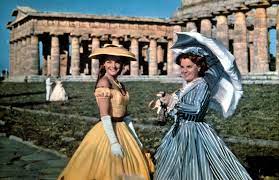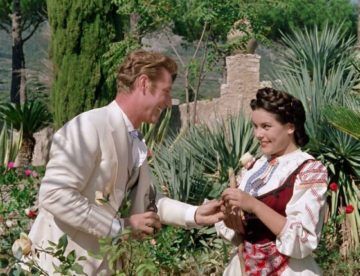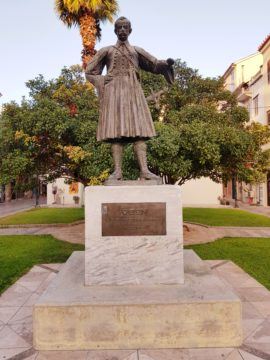by Rafaël Newman

Last month, after a three-year hiatus imposed by the pandemic, I was again able to participate in a once regular study-abroad junket, assisting a professor at the Swiss university where I serve as adjunct. The professor, to whom I happen to be married, was leading a group of 22 students on so-called Academic Travel, our university’s bi-annual USP: a ten-day sojourn in a country relevant to the topic of a course conducted otherwise in regular classes on the university’s campus in Lugano. The last time I went along on one of these trips, in 2019, the topic was commemoration of the Holocaust, and our destination was Poland, including the Auschwitz memorial site and the Jewish Cemetery in Łódź. This time, during the 2022 fall semester, the course was entitled “Writing and Re-Writing the Classics”; the primary texts were by Homer and Aeschylus and their respective modern interpreters; and we were bound for Greece.
Academic Travel traditionally follows midterms, so by the time we arrived in Athens the students had already read and discussed the Odyssey, in a new translation by Emily Wilson, as well as Circe (2018), Madeline Miller’s Stoppard-esque, “novelized” revision from the POV of a minor character. The syllabus called for them to turn now to the Oresteia, Aeschylus’s three-play account of the curse on the house of Atreus and our only extant tragic trilogy. On return to regular classes in Lugano in November, the class would then begin reading and discussing House of Names (2017), Colm Tóibín’s polyphonic re-writing of the tragedy, and consider the Irish author’s reframing of the ancient myth with a modern sensibility, his contemporary take on the psychological and, indeed, legal matters at stake in Aeschylus’s drama.
Accordingly, in Athens, the students visited the Acropolis and viewed the Parthenon, the temple sacred to Athena, the goddess who settles the legal dispute with which the Oresteia concludes, as well as the Areopagus, the craggy outcropping to the northwest of the Acropolis where this conclusion is staged; they toured the massive ruins of the “Cyclopean” fortress at Mycenae, identified by Heinrich Schliemann as the home of Agamemnon, the Homeric king whose murder galvanizes the action of the trilogy; and, at the magnificent 4th-century BCE amphitheater at Epidaurus, famed for its uncanny acoustics and 14,000-spectator capacity, they performed their own re-writings of crucial scenes from the three plays (interrupted, alas, by an irascible guard demanding a permit from the Greek Ministry of Tourism). In their new takes on the ancient tragedies, the students added such modern ethical issues as domestic abuse, and the competing claims of familial and romantic love, to Aeschylus’s more alienating concerns (which include the obligation to exact blood vengeance in cases of matricide).

Not long after our arrival in Athens, following an initial seminar on the Oresteia held on the rooftop terrace of our hostel with a distant but arresting view of the Parthenon, we also visited the Acropolis Museum in central Athens. Designed by Bernard Tschumi and opened in 2009 to house the historic site’s movable artifacts, the Museum serves as well to demonstrate that Greece is indeed able to preserve the remaining antiquities currently held abroad, most notably in London, at the British Museum, and thus to leave the latter “with only a moral position” against returning the sculptures on display there. Those sculptures, long referred to as the Elgin Marbles and currently known, more diplomatically, as the Parthenon Marbles, were removed from their original site in the early 19th century by the Englishman Thomas Bruce, 7th Earl of Elgin, allegedly by official permission of the Ottoman authorities, at the time the rulers of what is now Greece; they include large sections of the frieze that once ran around the entire temple and which is thought to depict, among other things, the procession held in honor of Athena at the Panathenaic festival. And it was that procession, finally, which interested us most during our tour of the museum, since in the classical period it involved the ritual presentation to Phidias’s mighty statue of the Parthenon’s eponymous goddess (parthenos = virgin, Athena’s sacred status) of a peplos, an enormous robe woven by specially selected Athenian girls.
The depiction on a mighty civic structure of a procession to reinvest a patron goddess with sacred power was of particular significance to us, in our course on “Writing and Rewriting the Classics,” for a number of reasons. As we moved from the archaic period of Homer to the classical period of Aeschylus and fifth-century Athens, we began to realize that what we were calling “the classics”—and viewing as the primitive templates for putatively more sophisticated, often simply more ironic early modern, modern, and post-modern re-writings by such authors as Racine, Joyce, O’Neill, Charles Frazier, Anne Carson, Kae Tempest, and of course Miller and Tóibín—had themselves always already been re-writings. Aeschylus himself had famously described his tragedies as “slices from the banquet of Homer,” miniature illuminations of individual episodes from the vaster canvas of the epic poet which, despite such piety, he nevertheless felt entitled to revise and manipulate; Aeschylus’s younger contemporaries and fellow tragedians Sophocles and Euripides were to take even greater liberties with the mythical material they derived from archaic sources. Furthermore, as classicists like Jean-Pierre Vernant and Froma Zeitlin have shown, Attic tragedy not only constituted a formal aesthetic innovation and a revolutionary psychological model and “turning point in the history of the self”; it was also “a social and public phenomenon, sponsored by the polis in fifth-century Athens”—in other words, it served a literally political function. Viewed alongside the Parthenon, that other great public work of Periclean demokratia, with its celebration of the burgeoning, para-imperial power of Athens in the wake of its triumphant role in the defeat of the Persians, and its presentation of a ritual to renew the potency of the city-state’s eponymous martial divinity, the similarly political nature of the Oresteia is made clearly manifest, alongside its significance as a creative revision of ostensibly timeless mythical material.
*
Between trips to archaeological sites and museums, and after gathering to discuss our findings in seminars, we behaved like ordinary holiday-makers in Greece. We consumed stupefying quantities of taramas, stifado, and chtapodia. We attended a live performance of bluesy rebetiko music and explored the Exarcheia neighborhood of Athens, recent site of anti-austerity protests and counter-culture happenings, now invested with a menacing police presence. We scaled a volcano and inspected an olive plantation on Methana peninsula across the Saronic Gulf from Athens. We wrote postcards adorned with thick-tressed caryatids and pompom-slippered Evzones. And we descended into our current age’s collective imaginary and perpetual theater festival, Netflix, which is where the professor and I, relaxing of an evening in our provisional digs, discovered an uncanny contemporary iteration of that very re-writing of traditional material we were examining with our students, and of the theme of sacred investiture, for political purposes, of a female figure.
Die Kaiserin (The Empress), which aired on September 29, is a six-part German miniseries run by Katharina Eyssen based on the early life of Duchess Elisabeth Amalie Eugenie in Bavaria (1837-1898), who married Kaiser Franz Joseph I in 1854 to become Empress of Austria and, in 1867, Queen of Hungary. The show takes significant liberties with a life that has become, if not mythical, then certainly legendary, thanks in large part to Elisabeth’s personal travails—what some, in a careless moment, might be tempted to term “tragic”—, her role as the penultimate female Hapsburg monarch, her own idiosyncrasy and reclusiveness, the glamor surrounding her person, and her assassination, a fin-de-siècle harbinger of the nationalist revolts that were to bring down the empire following the Great War. There is for instance a subplot, evidently wholly invented, involving foiled sedition by Franz Joseph’s younger brother Maximilian, the future ill-fated Emperor of Mexico; and there is the smuggling into the corps of Elisabeth’s ladies-in-waiting of a supposititious noblewoman, in actuality a would-be assassin, and her murderous attempt to avoid detection. And yet, for all that the series seems intent on embroidering the enigmatic life of a member of one of Europe’s oldest dynasties, and thus re-writing historical fact, its “primary text” is in fact another “fictionalization” of history: indeed, a form of modern “classic”.

For nearly seven decades now, once a year in the German-speaking world, with ritual regularity at Christmas time, public television stations have broadcast the three Sissi films. The trilogy, effectively a miniseries avant la lettre, is an Austrian production directed by Ernst Marischka that premiered between 1955 and 1957. It recreates the early years of Duchess Elisabeth in Bavaria, known as Sissi; her marriage to Franz Joseph; and the vicissitudes of her subsequent life as a regent and young mother at the Viennese court, in her fulfilment of royal duties in Hungary and Italy, and during her convalescence from tuberculosis on Madeira and Corfu. The films, which have enjoyed consistent popularity since their first showing, are lent extra piquancy by the fact that their star, the Austrian-born, German-French actress Romy Schneider, plays in them alongside her actual mother, Magda Schneider, in the role of Princess Ludovika of Bavaria, the historical Empress’s mother; by Romy’s refusal to participate in a planned fourth feature, leaving a mawkish (and counterfactual) reunion of mother and child in Venice as the trilogy’s anticlimactic conclusion, if not quite cliffhanger; and by the subsequent career choices made by Karlheinz Böhm, the Vaseline-lens-dreamy leading man who played Emperor Franz Joseph in all three films, but went on to be deliberately cast against type as a psycho killer. The movies have in the interim also acquired a morbidly fateful allure with the pathos of Romy Schneider’s premature demise, at the age of 43 in 1982, possibly due to the effects of alcohol abuse following the accidental death of her young son: which dreadful occurrence echoes the early deaths of two of the Empress Elisabeth’s own children, one in infancy, the other to suicide, and Sissi’s subsequent life as a semi-recluse, with eccentric, possibly dangerous dietary habits.

Beneath their uncanny, para-textual aura, however, the Sissi films are a pastel-hued confection, filmed on location in various historically accurate, romantic settings, and with the same lush Agfacolor technology used for the Hollywood versions of such classic American musicals as Brigadoon and Seven Brides for Seven Brothers. They marry classic rom-com mix-ups with Vaudevillian slapstick and double takes, those last mostly provided by the handsome but buffoonish Major Böckl, Sissi’s chevalier, who learns the local tongues of his Empress’s various sojourns in order to woo native damsels. (The fictional Böckl’s linguistic aptitude stands in for Elisabeth’s own private interest in literature and her talent for languages both ancient and modern, reduced in the films to her learning Hungarian in order to cement the double monarchy’s power.)

More crucially, the films stage the Byzantine cruelties of the Spanish court ceremonial in force at Schönbrunn as a personalized soap opera pitting Sissi, a charming ingénue, against her haughty but ultimately human aunt-cum-mother-in-law Sophie, whose initial edict that the Empress not mother her own children is softened by maternal sentiment. Archduchess Sophie, in the films, is also the rigid power behind the throne of her son, Franz Joseph, whom she has schemed to make Emperor, and who urges him to give an appropriately severe response, in the name of preserving dynastic hegemony, to the revolutionary nationalism of Hapsburg’s peoples: a will he resists, in a suspenseful scene in the second film, when he pardons a group of rebels rather than seeing them executed.
The corresponding sequence, in an early episode of the new miniseries, strikes the more somber note of the revision. Beset by grave misgivings, the Netflix Franz Joseph nevertheless signs the order for the execution of the rebels, and, with the mildly hysterical employment of a brooch to covertly inflict pain on his own person, also witnesses their hanging, remarking to an icy Archduchess Sophie that “there are things one never gets used to”— an intertextual wink at a German-speaking audience well versed in Sissi orthodoxy, and a warning that things will be different this time around.

And different they are indeed. Although the new series, like the films, remains faithful to the apocryphal articles of the Sissi creed—that the future Empress first encountered her husband to be in a meet-cute at Bad Ischl; that she was peremptorily and scandalously preferred to her elder sister Helene, Franz Joseph’s official intended; and that the imperial couple enjoyed a passionate, if rocky, intimacy—it departs in significant ways, both narrative and aesthetic, from Marischka’s “classic” fairy-tale treatment of the final glory years of the Austro-Hungarian Empire. Eyssen’s Elisabeth finds herself at the mercy of a positively sadistic Archduchess Sophie, played by Melika Foroutan in a fright wig reminiscent of Elsa Lanchester and with a lascivious potential violence that is part Jocasta, part Charlotte Corday in Peter Brooks’s staging. The Emperor’s seditious brother Maximilian is similarly Marat/Sadean, adept of orgies and bare-torsoed, tousle-haired conspiracy planning. And even Sissi’s father, Duke Max Joseph in Bavaria, a charming country bumpkin in the Marischka films given to dispensing rustic wisdom and melting at the sight of a new-born, becomes in the Netflix series a sinister wastrel, whose priapism and Saturnine alcoholism are morosely accepted by his resigned daughter.

But Die Kaiserin’s most effective make-over is reserved for its title figure. The revamp, while subtle, is the more devastating for its restraint: after all, the show’s writers (four are credited), all of them born in the Federal Republic between the mid-1970s and early 1980s, were undoubtedly exposed to the Sissi films during their formative years, and must thus have been sorely tempted to go Sid and Nancy on Romy Schneider’s Little Miss Goody Two-Shoes swooning over her Franzl, effectively a living Disney Princess and her Ken Doll (sorry-not-sorry for the mixed metaphor). But the series leaves full-on punk treatment of the Empress to Marie Kreutzer’s new film Corsage; instead, the Netflix Country Mouse turned Kaiserin, as played by the young Turkish-German actress Devrim Lingnau, delivers a nuanced critique of the hypocrisies and compromises of monarchic rule following the 1848 revolutions. Lingnau’s Elisabeth smolders with sexual desire, violently resists the intimate incursions into her person by the virginity-certifying representatives of the Catholic church, reflects the viewer’s revulsion at Archduchess Sophie’s counter-Oedipal hold over her son the Emperor, and, in the Empress’s own relationship with the assassin masquerading as her confidante, delivers an object lesson in intersectional feminism. But the series performs its deftest revision of the Sissi legend in a scene in which Elisabeth is first laced into her notorious corset by the formidable Countess Esterházy, Sophie’s lieutenant and major domo, with whom the Netflix Archduchess evidently maintains an S&M relationship. Under her mother-in-law’s pitiless gaze, Elisabeth panics as she realizes that she is unable to breathe properly—and that this is to be her fate for the rest of her life. And the informed viewer recalls with a frisson of horror that, when the historical Empress Elisabeth was assassinated, quayside on Lake Geneva in 1898, she is said not to have noticed that she had been fatally stabbed until boarding her vessel, so constrained and numbed was she by her accustomed corset—by the sacred peplos that her exalted status obliged her to wear.

In the concluding moments of the sixth and final episode of Die Kaiserin, the revised figure of the fated, hounded Elisabeth is transformed into a prototype of Lady Diana, the “Princess of Our Hearts,” when she walks unescorted into a torch-bearing throng of angry peasants (yes, really) to announce her eagerly awaited pregnancy, fall to her knees in humility, and win back her mutinous people’s respect for the House of Hapsburg: a sacrifice offered to progress in order to preserve tradition. This Elisabeth, however, since she does not expire immediately but is instead reabsorbed into the hegemonic machine, is also an iteration of another classical avatar. The Oresteia concludes, in its third and final play, with Athena’s transformation of the chorus of Erinyes, or Furies, who have been pursuing the matricide Orestes, into the tragedy’s eponymous Eumenides, or “Kindly Ones,” henceforth to serve a newly established Athenian justice system: “Your magic is working . . . I can feel the hate, the fury slip away,” the chorus sings, as it succumbs to Athena’s offer of a permanent home in the burgeoning regional power center of Athens. Elisabeth, in the series’ conclusion, has been similarly propitiated, transformed from a bolshy upstart demanding that her rights as a woman be respected into a worthy representative of the House of Hapsburg—and an indispensable cog in its reproductive machinery. And of course, in the Oresteia, Athena and Apollo also notoriously elaborate a defence of Orestes based on the conceit that mothers are not actually related to their children, but are simply hosts, and that their murder by these “children” thus does not automatically compel blood vengeance. (And see, for a continuation of this mother-virgin complex, as well as of the pagan custom of clothing divine effigies, into the Christian era, the regular dressing of the Black Madonna at Einsiedeln.) As for the Hapsburgs, their notoriously coquettish maxim says it all:
Bella gerant alii, tu felix Austria nube.
Nam quae Mars aliis, dat tibi diva Venus.
Let others go to battle; thou, happy Austria, make marriages. / Let divine Venus grant thee what Mars grants the rest. In other words: “Make love, not war.” And, although the Hapsburgs were by no means a pacifist clan, and were unafraid to exert their ancestral rights, and expand their territories, by show of arms, their principal strategic weapon was a system of cunningly arranged inter-dynastic marital alliances, and the resultant production of heirs to the throne. All of which required the acquiescence, not to say subjugation, of a series of sacred females-cum-babymakers.
*
Of course, it is the investiture of a rather different figure, among the crowned heads of Europe, that commands the attention of today’s royal watchers, with the coronation of King Charles III slated to take place in England on May 6 of next year. Charles’s age and gender, as well as the distinct anti-glamor of his personal life, make him less susceptible to the sort of nationalist allegorizing to which Elisabeth was subject—to say nothing of the current state of British nationalism. Furthermore, and to belabor the obvious, he is a man, and thus conventionally unavailable as a vessel, either rhetorically, for abstraction and metaphor (“Patria,” “La République”), or biologically, for heirs and spares (anyway, he’s already completed his part of that deal).
And yet. As I was strolling the twee old town of Nafplio, the city on the Argolic Gulf in the Peloponnese that we had chosen as the staging ground for archeological excursions in the second half of our trip, I found myself considering two statues, as they considered each other across an intersection. Positioned to face the old town and the marina in the west end of the city is the effigy of Ioannis Kapodistrias, the first head of modern Greece, a dapper 19th-century statesman in western garb who led the Hellenic State freshly liberated from Ottoman rule from 1827 until his assassination in 1831, in Nafplio, which was at the time the capital of the young country. Across from the square featuring the Kapodistrias monument, meanwhile, and facing east, is the likeness of “Othon, King of the Hellenes,” and the dates of his reign: 1832-1862. This statue commemorates the initial attempt on the part of the “Great Powers,” following the defeat of the Ottomans in the Balkans, to impose an absolute monarchy on the feuding newborn state by seating Otto, a member of the Bavarian House of Wittelsbach—to a junior line of which Sissi’s family belonged—on the Greek throne. Otto was later to abdicate, making way for a constitutional monarchy and, eventually, successive forms of demokratia. But his statue remains, prominently situated in the now provincial former capital: gazing towards the “Orient,” the imaginary birthplace of so many European fantasies of domination, and clad in the traditional fustanella, a longer version of the tunic worn by the Evzones soldiers outside the Athenian parliament (once the palace) and made famous by Lord Byron (1788-1824), who wore it during his participation in the wars to liberate Greece.

Here, then, is an example of a male figure made to sport a particular ritual dress in order to assert political dominion. And although neither King Otto in the nineteenth century nor King Charles in the twenty-first will have been subject to precisely the same biological dictates as Empress Elisabeth, yet their investiture is a reminder that the rhetorical trope—of clothing, and re-clothing, a human figure in the trappings of sacred power—persists; and that it will continue to exert its arbitrary power, at least for as long as we continue to lend it credence.
